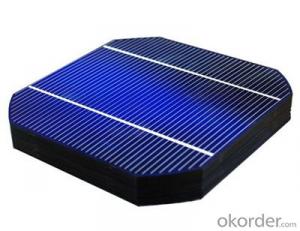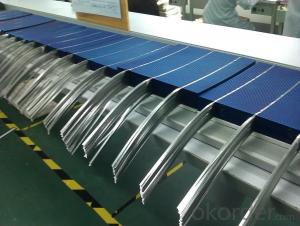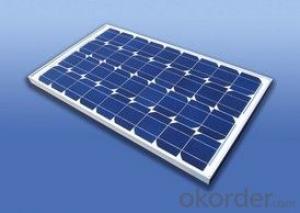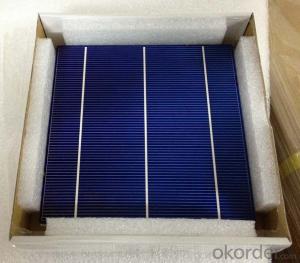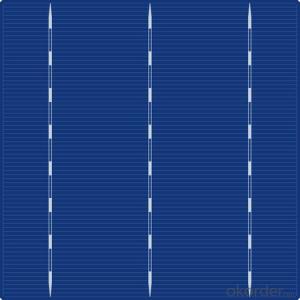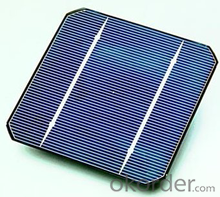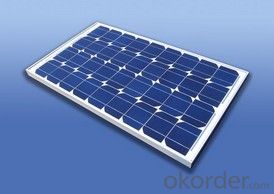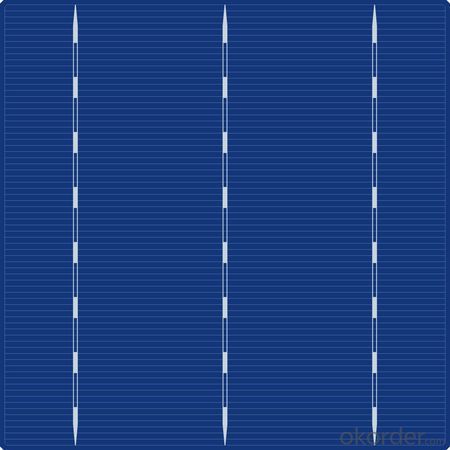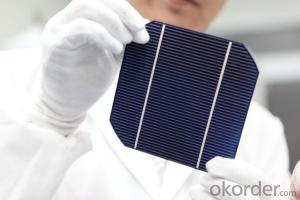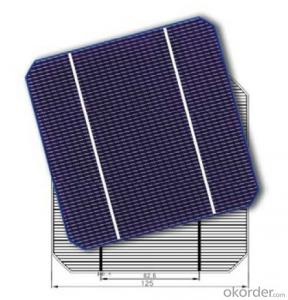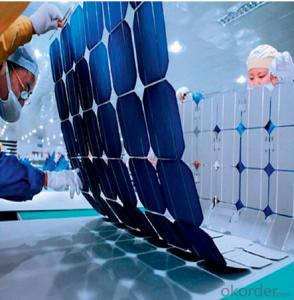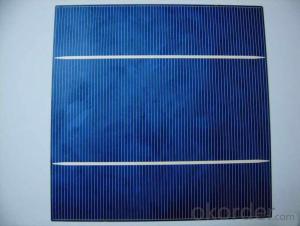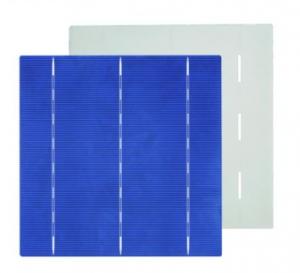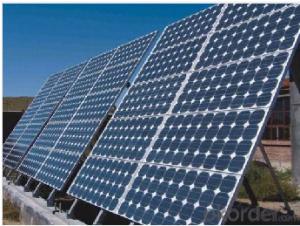Utj Solar Cells - Monocrystalline Silicon Solar Cells 125mm (16.50%-18.35%)
- Loading Port:
- Shanghai
- Payment Terms:
- TT OR LC
- Min Order Qty:
- 1000 watt
- Supply Capability:
- 100000000 watt/month
OKorder Service Pledge
OKorder Financial Service
You Might Also Like
Specification
1.Description of the Solar Cells
Monocrytalline Silicon Solar Cells 125mm (16.50%----18.35%)
We supply regular mono 125x125mm and poly 156x156mm solar cells.
Cells made in China mainland and Taiwan are both available.
Cell production capacity yearly reach 1GW.
Our cells pattern include continuous and uncontinuous busbar to meet different cells line.
2.Mechanical data and design of the Solar Cells
| Format | 125 mm × 125 mm ± 0.5 mm |
| Thickness- | 210 μm ± 40 μm |
| Front (-) | 1.6 mm bus bars (silver),blue anti-reflection coating (silicon nitride) |
| Back (+) | 2.5 mm wide soldering pads (silver) back surface field (aluminium) |
3. Temperature Coefficient of the Solar Cells
| Voc. Temp .coef.%/K | -0.35%/K |
| Isc . Temp .coef.%/K | +0.024%/K |
| Pm. Temp. coef.%/K | -0.47%/K |
4.Electrical Characteristic of the Solar Cells
Efficiency (%) | Pmpp (W) | Umpp (V) | Impp (A) | Uoc (V) | Isc (A) | FF (%) | ||
18.35 | 2.841 | 0.532 | 5.342 | 0.631 | 5.67 | 79.41% | ||
18.2 | 2.817 | 0.53 | 5.319 | 0.631 | 5.64 | 79.16% | ||
18.05 | 2.794 | 0.527 | 5.301 | 0.63 | 5.63 | 78.77% | ||
17.9 | 2.771 | 0.527 | 5.259 | 0.629 | 5.62 | 78.39% | ||
17.75 | 2.748 | 0.526 | 5.224 | 0.629 | 5.61 | 77.88% | ||
17.6 | 2.725 | 0.524 | 5.201 | 0.629 | 5.59 | 77.50% | ||
17.45 | 2.702 | 0.52 | 5.196 | 0.629 | 5.586 | 76.90% | ||
17.3 | 2.678 | 0.516 | 5.183 | 0.626 | 5.577 | 76.71% | ||
17.15 | 2.655 | 0.513 | 5.175 | 0.623 | 5.565 | 76.58% | ||
17 | 2.632 | 0.51 | 5.161 | 0.622 | 5.559 | 76.12% | ||
16.75 | 2.593 | 0.508 | 5.103 | 0.615 | 5.477 | 76.98% | ||
16.5 | 2.555 | 0.506 | 5.047 | 0.608 | 5.396 | 77.88% | ||
5.Intensity Dependence of the Solar Cells
Intensity [W/m2] | sc× [mA] | Voc× [mV] |
1000 | 1.00 | 1.000 |
900 | 0.90 | 0.989 |
500 | 0.50 | 0.963 |
300 | 0.30 | 0.939 |
200 | 0.20 | 0.920 |
6.IV Curve of the Solar Cells
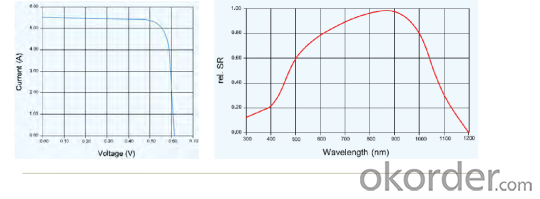
7.Applications of the Solar Cells
electric power generation
8.IMages of the Solar Cells

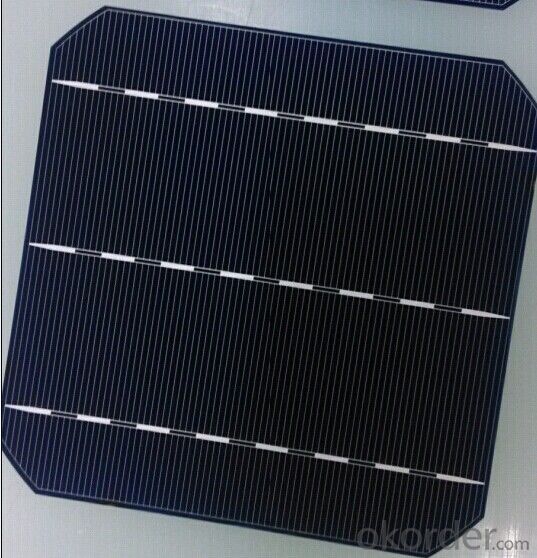
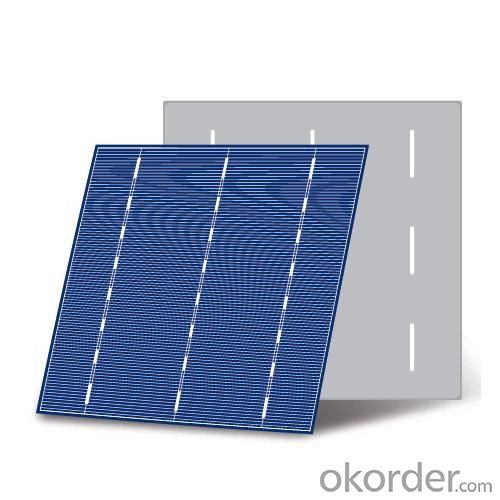
FAQ
- Q: How can I explain to my 10 year old daughter what solar cells are?
- Solar cells are the cell that can collect the solar energy from nature.
- Q: What is the impact of fire hazards on solar cells?
- The impact of fire hazards on solar cells can be significant and detrimental. Fires can cause direct damage to the cells, resulting in their complete destruction or impaired performance. The high temperatures and flames associated with fires can melt or warp the delicate components of solar cells, rendering them useless. Additionally, the smoke and ash produced by fires can settle on the surface of the solar panels, reducing their efficiency by blocking sunlight. Therefore, fire hazards pose a significant risk to the functionality and longevity of solar cells.
- Q: Briefly explain why solar cells are made into components
- Components are made in order to better protect the crystalline silicon material is not destroyed, the components generally by the tempered glass, EVA, battery, TPT, aluminum frame and other materials, so that the components, the service life of up to 20 years The
- Q: Can solar cells be used to power air conditioning systems?
- Yes, solar cells can be used to power air conditioning systems. Solar panels can generate electricity from sunlight, which can then be used to power air conditioning units. However, the size and efficiency of the solar panel system would need to be carefully considered to ensure it can generate enough electricity to meet the demands of the air conditioning system.
- Q: Can solar cells be used in off-grid applications?
- Yes, solar cells can be used in off-grid applications. Off-grid applications refer to situations where there is no access to the traditional electricity grid. Solar cells, also known as photovoltaic cells, convert sunlight directly into electricity, making them a reliable source of power for off-grid applications. They can be used to generate electricity for various purposes, such as powering homes, buildings, or remote installations in areas without access to the grid.
- Q: Want to use solar panels and batteries to produce a power supply that can provide a stable voltage, how can you connect? Can you connect directly with the solar panel to the battery while the battery power supply is feasible?
- Solar cells and battery connection, it is best to use a photovoltaic charging controller, which can control the output voltage of solar cells can protect the battery is not overcharge, but also at night when the solar cell does not generate electricity, to prevent the battery power back
- Q: What is the internal structure of solar panels
- In addition to the quality of EVA itself, the components of the manufacturers of the laminated process is also very large, such as EVA glue degree is not up to standard, EVA and tempered glass, backplane bonding strength is not enough, will cause EVA early aging, Affect component life.
- Q: Can solar cells be used to power large industrial facilities?
- Yes, solar cells can be used to power large industrial facilities. With advancements in solar technology and the availability of large-scale solar installations, solar power has become a viable option for industrial-scale electricity generation. By deploying a sufficient number of solar panels, along with efficient energy storage systems, it is possible to meet the energy demands of large industrial facilities and reduce their dependency on conventional power sources.
- Q: What is the impact of solar cells on reducing air pollution from power generation?
- Solar cells have a significant impact on reducing air pollution from power generation. By harnessing the sun's energy, solar cells produce clean electricity without emitting harmful pollutants like carbon dioxide and other greenhouse gases. This reduces the reliance on fossil fuels, which are major contributors to air pollution and climate change. Additionally, solar cells help to decrease the release of other harmful pollutants, such as sulfur dioxide and nitrogen oxides, which are commonly emitted during traditional power generation. Overall, the widespread adoption of solar cells can greatly contribute to improving air quality and mitigating the adverse effects of power generation on the environment.
- Q: How do solar cells work to become the solar energy?
- Solar cells are a material used in producing solar energy. There are also many kinds of solar cells based on it's material and usage.
Send your message to us
Utj Solar Cells - Monocrystalline Silicon Solar Cells 125mm (16.50%-18.35%)
- Loading Port:
- Shanghai
- Payment Terms:
- TT OR LC
- Min Order Qty:
- 1000 watt
- Supply Capability:
- 100000000 watt/month
OKorder Service Pledge
OKorder Financial Service
Similar products
Hot products
Hot Searches
Related keywords
